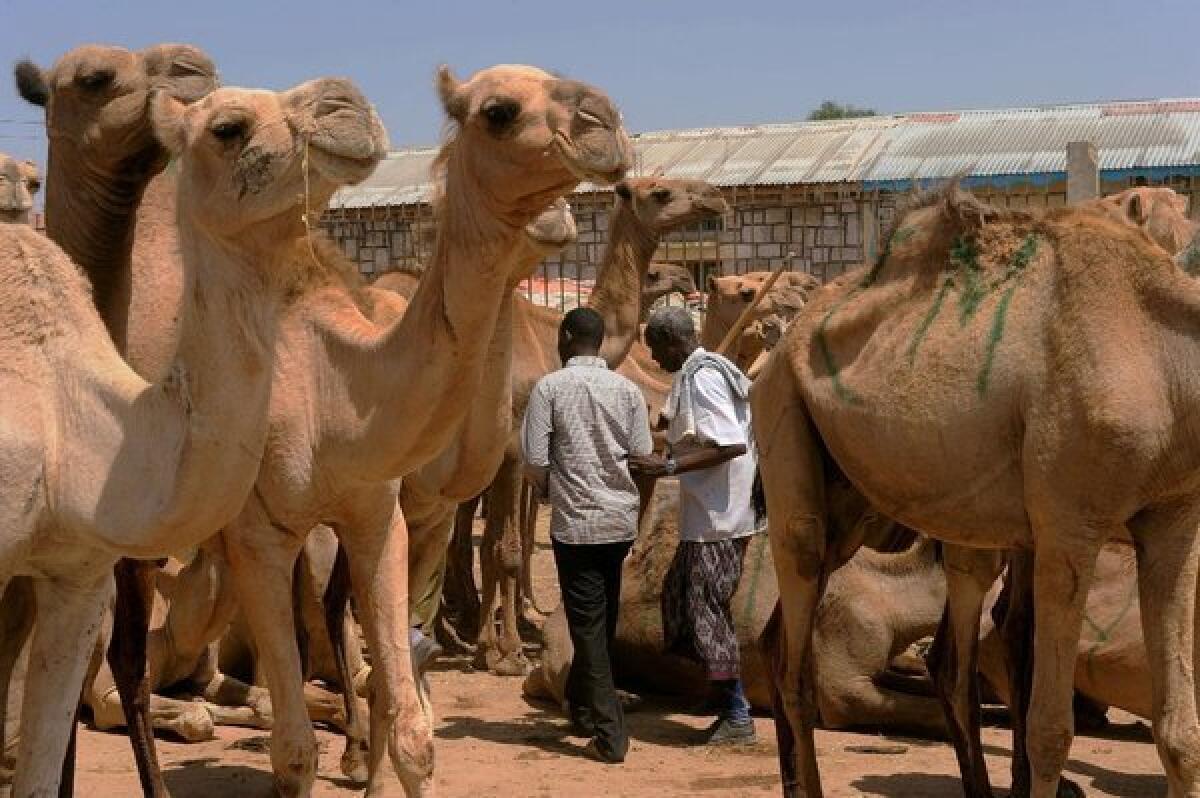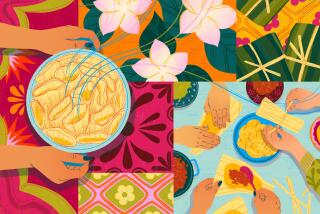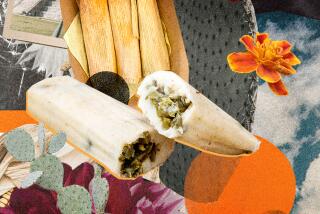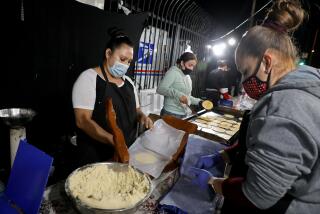Camel meat and me: A culinary saga

- Share via
Not long ago, the travel website Roads & Kingdoms reported that the African nation of Somaliland had put its faith in a new export to raise itself from poverty: camel meat.
“Somaliland’s future prosperity may just ride on the camel,” the author wrote.
We shall see. As one of the few Americans who has actually partaken of this, um, delicacy, I thought I’d share my experience.
It was August 1992. The place was Mogadishu, Somalia, where I was reporting on the civil war that had broken out after longtime dictator Mohamed Siad Barre fled the country, leaving his capital city in the hands of two mutually antagonistic warlords.
This was months before U.S. troops landed to manage the relief effort, the disaster described in the book and movie “Black Hawk Down.” To get into the country, reporters relied on occasional flights out of Kenya on U.S. military C-7 Caribou cargo planes bringing supplies to United Nations personnel.
Because the main airport was regularly shelled, the Caribous landed at a dirt airstrip a few miles out of town. The pilots kept their engines turning while pallets of goods were slid down a ramp in the rear and the passengers deposited on the ground.
The plane then immediately took off, barely having come to a stop. When the dust cloud settled, we could see a line of technicals waiting to take us into the city.
What was a “technical”? It was a converted pickup truck, usually painted mustard yellow. For a daily rent of $150, cash (usually shared among two or three visiting hacks), you got a driver, a guard armed with a Kalashnikov to sit with him in the front seat, and a barefooted 13-year-old boy to tend the machine gun bolted to the truck bed.
Your technical would take you anywhere you wanted to go unless you wanted to cross the green line dividing the turfs of the warlords Mohamed Farah Aidid and Ali Mahdi Mohamed. In that case, your driver dropped you off, you walked across, and you picked up a ride on the other side.
We drove into an anarchic city, past marketplace stalls festooned with camel legs, down to the hooves, hanging overhead. In our naivete we wondered what that was all about -- aphrodisiacs? Good-luck charms?
Every passing vehicle seemed to bristle with gun barrels sticking out the windows; every male on the street, even the children, carried a weapon. At the port of Mogadishu, an average of five people were killed every day. Scarcely a relief ship docked without being looted.
In one episode, mobs emptied a dockside warehouse of 7,000 tons of food in 10 hours. “The whole population of Mogadishu was running around looking like ghosts because they were covered in wheat flour,” a relief worker told us. “It was a free-for-all.”
Every reporter followed a timeworn routine. You made an obligatory stop to see the last foreign diplomat still stationed in Mogadishu, the lugubrious Egyptian ambassador. “I must have made someone in Cairo very angry,” he told us.
You tried to get all your work done by about 2 in the afternoon, for the Somalis chewed leaves of the stimulant plant khat all day and once the drug kicked in, the atmosphere on the street became, shall we say, various.
At one point, we turned a corner and came on two armed gangs facing off against each other across an alleyway, plainly up to no good. Our driver kept edging closer to the mob while we pounded on his shoulders and screamed at him to get out of there; finally he shifted into reverse and backed away. “I thought you wanted to see city,” he said woozily.
Nighttime accommodations were provided at the U.N. compound’s upstairs dormitory. The crack of gunfire persisted through the night. As a rule, you placed your mattress on the floor to sleep, for you never knew when a stray bullet might come pinging through the open window.
Dinner was served family style at a long table and consisted, yes, of gray hunks of camel. The gamy meat was tough and stringy, with the consistency of sandpaper, a sign that the slaughtered animal was well past the bloom of youth.
You washed the meal down with a gloppy, white fluid poured from a pitcher. This was camel milk. It was served warm and gave off an aroma like bacon. I can honestly say that it was the single most repulsive foodstuff I have ever ingested. Sometimes I can still taste it, even now.
The Somaliland travelogue’s author, Mark Bay, says there’s a technique to making camel palatable, though it hasn’t yet reached the Horn of Africa. The global market for camel milk is said to be worth $10 billion. Somaliland officials paint word pictures of a “growing, universal market for camels,” and pitchmen mention a “spike in demand” from Europe, Japan and America.
Americans have welcomed ostrich, bison, croc and any number of other exotic meats to their tables. But camel? The ship of the desert may have a steep hill to climb.
More to Read
Sign up for The Wild
We’ll help you find the best places to hike, bike and run, as well as the perfect silent spots for meditation and yoga.
You may occasionally receive promotional content from the Los Angeles Times.







